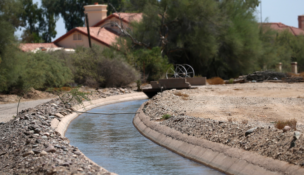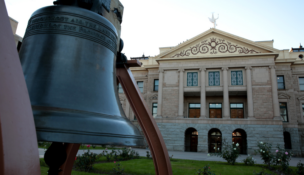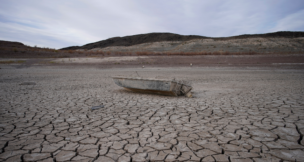Arizona Indian Tribes offer court their view on protecting the bald eagle
Arizona Capitol Reports Staff//February 8, 2008//[read_meter]
Arizona Indian Tribes offer court their view on protecting the bald eagle
Arizona Capitol Reports Staff//February 8, 2008//[read_meter]
Four Arizona Indian tribes filed last-minute amicus briefs in a year-long lawsuit over whether Arizona’s bald eagle is an endangered species.
Though a bit late to the table, the tribes still had their day court.
The case first landed in U.S. District Court in January 2007. The Center for Biological Diversity sued the Interior Department for removing Arizona’s bald eagles from the Endangered Species list. The Maricopa Audubon Society signed on as a co-plaintiff.
The two sides argued their case Feb. 5 before U.S. District Court Judge Mary Murguia in Phoenix. More than 100 people packed the gallery. Four elderly women from the San Carlos Apache Tribe sat in one row, all wearing traditional dresses.
Like the other three tribes, the San Carlos Apaches opposed the bald eagle’s delisting. Lawyers for the tribes sat with their clients in the gallery.
After lawyers for the plaintiffs and the defendant had their say, however, the judge asked the tribes’ attorneys to come forward and speak.
Joe Sparks represented the San Carlos, Tonto Apache and the Yavapai-Apache tribes. Charleen Greer spoke on behalf the Salt River Pima-Maricopa Indian Community.
Sparks told the judge that the bald eagle has cultural and religious significance for the tribes. It is more than wildlife in need of protection, he said.
“This is an extended family whose English name is the bald eagle,” Sparks said.
He said the tribes would not share even with him all of the bald eagle’s religious and sacred meaning.
Greer echoed the sentiment.
“There are certain things about the eagle and their sacredness they will not share with me,” she told the court.
Early in the proceedings, Murguia asked the tribes’ lawyers why the amicus briefs had been filed so late – both within a week of the hearing.
Sparks said it was more than a matter of talking to the Tribal Council.
“We needed to consult with the elders and holy representatives of the tribe,” Sparks said.
Discussion included what elders deemed appropriate for him to tell the court, he said in a later interview. Even before speaking to him, he said, elders and religious leaders had to prepare what they would say. They also had to prepare Sparks for hearing what they had to say, as well as make sure he could be trusted with the information.
Sparks told the court: “It took us that amount of time to get their permission to say what we said.”
Oral arguments focused, in part, on whether the Arizona’s bald eagle – known as the desert bald eagle – should have been excluded when the Interior Department delisted the bald eagle nationwide last July.
The department and the agency that reports to it – the U.S. Fish and Wildlife Service – already had rejected an earlier petition by the center not to delist Arizona’s bald eagles.
In the lower 48 states, the bald eagle has made a remarkable comeback under endangered species protection. Some 10,000 breeding pairs exist today, up from fewer than 500 in 1963, according to Fish and Wildlife.
However, only 53 nesting pairs – or fewer by some accounts – exist in Arizona.
But the center had argued it’s not just the numbers. Desert bald eagles make up “distinct population segment” and require a separate review to determine if they’re still endangered.
Among other things, the center said, desert bald eagles do not breed outside the population segment.
Dan Rohlf, the center’s lead attorney, told the court: “They have adapted to the conditions of the desert Southwest.”
If the desert bald eagle’s population crashed, Rohlf said, it would leave a large gap in the bald eagle’s range across the lower 48 states.
Without the protection of the Endangered Species Act, the fragile desert eagle population faces extinction, he said.
But referring to U.S. Fish and Wildlife, Rohlf said: “The agency has … literally written desert bald eagles off.”
The Interior Department’s attorney later agreed that the desert bald eagle was distinct.
But Lisa Russell suggested the center was looking through the wrong end of the telescope. The agency considered the bald eagle’s recovery throughout the lower 48, not just in Arizona.
“It’s not significant to the species as a whole. It doesn’t meet the significance criteria,” Russell said.
Murguia asked her if Washington administrators paid enough attention to field biologists, whose data suggested the desert bald eagle was distinct and unique.
“There were a lot of biologists who seemed to be very knowledgeable in this area,” Murguia said.
The judge brought up a July 2006 conference call. A handwritten note summarizing the call was entered as evidence. It strongly suggested that Fish and Wildlife officials in Washington ruled to delist despite the science, not because of it.
According the note, one caller said: “We’ve been given an answer, now we need to find an analysis that works.”
Russell said the comment was “much less sinister than how plaintiffs characterize it.”
She said the policy call represented a reasonable disagreement between agency officials and the field biologists.
On another matter, the judge asked Russell about the Fish and Wildlife’s apparent failure to consult with Indian tribes before delisting.
“It seems like the tribes were not put on notice,” Murguia said.
Russell said the tribes could have had input anytime since the 1990s, when the Interior Department first announced plans to delist the bald eagle. It was stated as a goal.
But lawyers for the tribes argued they weren’t asked for meaningful input after the agency denied the center’s petition against delisting in 2006.
In a brief filed by the three Apache tribes, Sparks and his associate Susan Montgomery wrote that Fish and Wildlife failed to perform a necessary review before taking action. The Endangered Species Act required that tribes be notified and consulted, according to the brief.
The input would have offered a valuable point of view, the brief stated. The agency had missed the chance “ to receive a wealth of highly relevant information regarding the desert eagle which has been maintained and preserved in the traditional knowledge of the
Apache People for as long as may be recalled,” according to the brief.
In addition, the failure to consult violated the trust responsibility the U.S. has with Indian tribes, according to the brief.
In addition, Sparks told Murguia that the Bald and Golden Eagle Protection Act is not a good fallback. As the law has been interpreted, he said, it would not protect the eagle habitats “if they stand in the way of progress, which from the developer’s point of view is a bulldozer.”
The center and the Maricopa Audubon Society asked Murguia to order the Fish and Wildlife Service to review the desert bald eagle’s status and take comments from Indian tribes, the public and wildlife experts. They also asked the judge to order the agency to list the desert bald eagle as endangered during the review period.
Murguia took the matter the under advisement.
Afterword, the four San Carlos Apache female elders relaxed in the lobby. They were accompanied by Sandra Rambler, cultural adviser to tribal Chairman Wendsler Nosie.
The Tribal Council, Rambler said, passed a resolution against delisting the desert bald eagle.
She added: “The federal government stole the bald eagle from us, made it their national symbol. Now they want to kill it.”
?
















